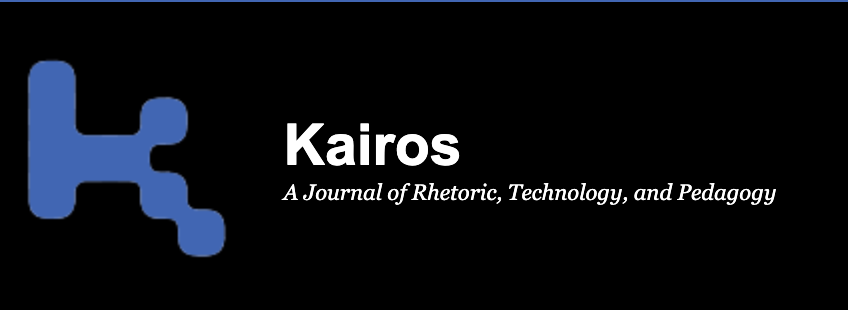About this Book

What We’re Doing
For as long as either of us can remember (or 2008, whichever came first), Doug and Cheryl have been planning to write a book about Kairos: A Journal of Rhetoric, Technology, and Pedagogy–and not just a book about the journal, but about how it fits within digital publishing writ large, both in the humanities and the social/sciences.
During the pandemic, we decided to use a little extra time we found by not commuting to our jobs to sit down every week and record roughly an hour of conversation, of dialogue, between the two of us—sometimes prompted by one of our managing editors or another staff member, as folks wandered in and out of these open recording sessions. Between March 3 and August 18, 2021, we collected over 17 hours of raw footage based on previous written work we had done over the years to outline the contents of this book.
And we've had help from a myriad of people who asked excellent questions, creating running logs of the raw video, made rough cuts of the videos, added branding and titles, and provided peer review and advice along the way. We are incredibly grateful to each and every one of them!
Doug and Cheryl continued to meet bi-weekly after the initial recordings were done, to work on writing, editing, and having so many conversations about where we wanted to publish this work: Our original plan (in 2008–10!) was a digital, scholarly book through a university press known for publishing eBooks in digital rhetoric. After a few failed attempts to get ourselves going, we took the pressure off to have a university press on board and decided just to write and design the thing the way we needed, knowing that it may not fit the content or technological platform of any given press, but knowing that the content was needed in the world, even if it wasn't marketable in any way a press might envision.
Our title—what to call this conglomeration of facts, stories, research, practice, and oral histories—has always been a bit of a conundrum for us (and, frankly, for presses). The original title for the book, way back in the aughts, started cheekily as Smart, Sexy Scholarship, because we liked the idea of playing with the formality of scholarly work in the same way that Kairos tries to push those boundaries. More recently, we played with the title Divine Timing of Digital Scholarship[1] as a play on the meaning of the Greek word kairos. However, we also knew—as something we experienced regularly with the journal itself—that the word kairos comes up in search engines as much related to Christian contexts as it does to the journal, and we didn't want some confused audiences wondering how they ended up reading about academic publishing when they came looking for God.
So we renamed the book yet again to Publishing Digital Scholarship: A How-To Guide and Oral History [of the Longest, Continuously Running Open-Access Scholarly Multimedia Journal]. It's a mouthful, and one that speaks directly to the content of the book, a book we have also colloquially always referred to simple as the "Kairos book." And that's, ultimately, how we got a domain name—kairosbook.online—that was easy to remember and best suited to our goals. If you, too, refer to this book in conversation as the Kairos book, we won't at all be offended. Just cite it by its long name. ;)
The need for a domain name became more pressing in 2023 when we finally decided to choose a platform for delivering the written and video content we wanted to share. We needed a delivery mechanism that would help us Get Shit Done and would ensure the content would be digestible, timely, and readable. We chose Ghost as our platform because it is open source, and Kairos subscribes to an open mission above all, and we could decide to monetize our dripped content, as the marketers say, should we choose to do so.
(We're still working out how this might work, and what its relationship to our Patreon account is. Ghost doesn't take money off the top like Patreon does, so there's good reason for us to transition to this platform solely for our support needs while also offering something of substance back to our patrons.)

Why We’ve Written This Book
We are pretty proud of the editorial accomplishments that have created Kairos, and this book is an attempt to more definitively showcase what Kairos is, how it works, why it's the longest continuously running scholarly multimedia journal, and why that's important. Our goal is to help people see how digital publishing works, quite literally, for an online journal (like Kairos, but also other digital journals) as well as to trace the history of scholarly journal-based digital publishing. While there are other scholarly and practical books that have traced a portion of this history—most notably Christine Borgman's work on the rise of digital scholarship for the "hard" sciences–that history for the humanities has rested solely in lore for the last three decades. It's time to get it down in print, as they say. And, frankly, we are pretty sure no one knows that history better than those of us who have been at it since the beginning of Web-based journal publishing in the humanities.
Why Should Anyone Care?
The easy answer is: People keep asking us for this record, this testament to the longevity and success of a journal like Kairos. And we DO want to share—we have always been open about our processes, from the very start of the journal. To get them organized and distributed for a readership outside of our staff, however, is a different proposition that took us some time. We're grateful you've been patient, and we think it's worth it.
This book is a work of practical sustainability. It speaks to the infrastructures we have written about elsewhere that are requisite for scholarly digital publishing to maintain itself: the social, scholarly, and technical. (Don't worry, we explore these in detail in the book!) This book is a record of preservation and a set of best practice options for digital scholarly stakeholders. It is 30 years of knowledge compiled into a (hopefully) fun-to-read/view and easy to reference guidebook + researched historical statement that adds to the field-tending a journal like Kairos and its editors feel beholden to participate in. We're doing this because we want to help, and we hope you can take some of this knowledge, wisdom, and fun and apply it to your own work in successful, sustainable ways.
Check out the Outline to continue reading.
Footnotes
[1] This is the first footnote in this book project, but certainly not the last! We imagine that we'll provide asides, both useful and useless information, and some inter-author commentary in these footnotes, taking inspiration from Michael Spooner and Kathy Yancey's "Postings on a Genre of Email" (CCC 47.2, 1996).
As Cheryl notes above, we considered Divine Timing, but quickly ran into the issue of the idea of "kairos" having been appropriated from the rhetorical tradition (see the linked Layers post for a history and definition) and reframed into a religious motif in the Bible (particularly in the books of Luke, 12:54-56 & 19:44 and Mark, 1:15). As rhetoricians, we should be attuned to audience expectations - and kairos clearly has multiple audiences who ascribe different meanings to the term...so to avoid confusion we opted to move away from using 'divine' as a term. Still, we do want to stress the idea of 'opportune time' represented in (both the rhetorical and religious) definition of kairos, as much of what we've done only has worked because it came at the right time (this will be a recurring theme in our oral history videos).
But time itself isn't really static, and it can be opportune in a given moment, or across a series of moments, or even in a recursive way (which is why Doug really wanted to add "Wibbly-Wobbly, Timey-Wimey" to the title or subtitle, but decided that these terms might also invoke audience-oriented confusion...he also has a note about the importance of "Morris Day and the Time" but can't recall what that might be.)
